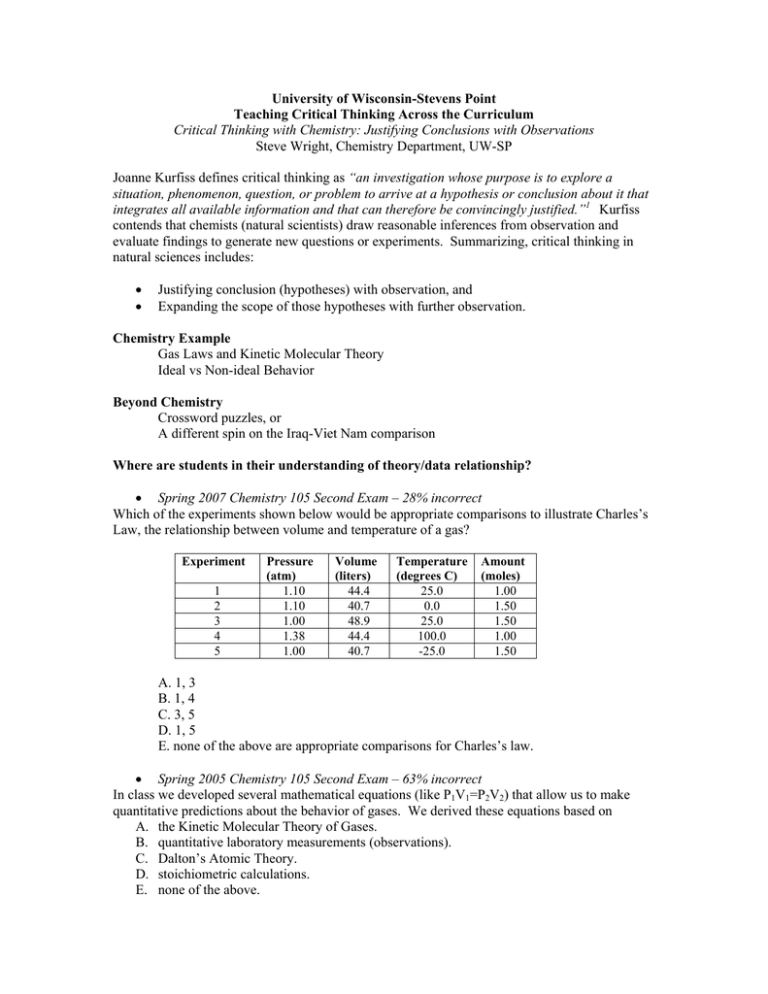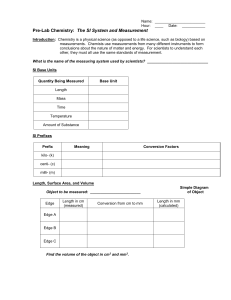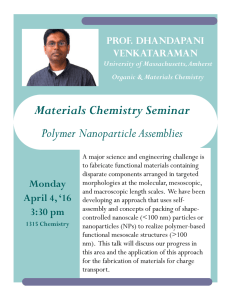University of Wisconsin-Stevens Point Teaching Critical Thinking Across the Curriculum
advertisement

University of Wisconsin-Stevens Point Teaching Critical Thinking Across the Curriculum Critical Thinking with Chemistry: Justifying Conclusions with Observations Steve Wright, Chemistry Department, UW-SP Joanne Kurfiss defines critical thinking as “an investigation whose purpose is to explore a situation, phenomenon, question, or problem to arrive at a hypothesis or conclusion about it that integrates all available information and that can therefore be convincingly justified.”1 Kurfiss contends that chemists (natural scientists) draw reasonable inferences from observation and evaluate findings to generate new questions or experiments. Summarizing, critical thinking in natural sciences includes: • • Justifying conclusion (hypotheses) with observation, and Expanding the scope of those hypotheses with further observation. Chemistry Example Gas Laws and Kinetic Molecular Theory Ideal vs Non-ideal Behavior Beyond Chemistry Crossword puzzles, or A different spin on the Iraq-Viet Nam comparison Where are students in their understanding of theory/data relationship? • Spring 2007 Chemistry 105 Second Exam – 28% incorrect Which of the experiments shown below would be appropriate comparisons to illustrate Charles’s Law, the relationship between volume and temperature of a gas? Experiment 1 2 3 4 5 Pressure (atm) 1.10 1.10 1.00 1.38 1.00 Volume (liters) 44.4 40.7 48.9 44.4 40.7 Temperature (degrees C) 25.0 0.0 25.0 100.0 -25.0 Amount (moles) 1.00 1.50 1.50 1.00 1.50 A. 1, 3 B. 1, 4 C. 3, 5 D. 1, 5 E. none of the above are appropriate comparisons for Charles’s law. • Spring 2005 Chemistry 105 Second Exam – 63% incorrect In class we developed several mathematical equations (like P1V1=P2V2) that allow us to make quantitative predictions about the behavior of gases. We derived these equations based on A. the Kinetic Molecular Theory of Gases. B. quantitative laboratory measurements (observations). C. Dalton’s Atomic Theory. D. stoichiometric calculations. E. none of the above. • Spring 2005 Chemistry 105 Second Exam – 79% incorrect The temperature of a sample of gas is directly proportional to its pressure. Which is the best theoretical explanation of this? A. gas particles strike the container with the same force, but over a smaller area. B. gas particles strike the container with greater force thus the force must be spread over a greater area. C. gas particles strike the container with greater force over the same area. D. if the temperature is doubled, the pressure doubles. E. if the temperature is doubled, the pressure is halved. • Spring 2005 Chemistry 105 Final Exam – 6% incorrect The pressure of a sample of gas held in a constant volume container increases as the temperature increases because A. the gas particles move faster, hitting the walls of the container with greater force. B. the gas particles move faster, hitting the walls of the container with less force. C. the gas particles move slower, hitting the walls of the container with greater force. D. the gas particles move slower, hitting the walls of the container with less force. E. none of these explain this observation. Learning Outcomes – Chemistry 106 1. Use and critique the scientific method as a process to develop theoretical constructs and/or solve problems. 2. Consider reasonable data/observations to draw justifiable conclusions and make informed decisions. 3. Use abstract concepts to develop well-reasoned solutions to problems. 4. Communicate convincingly when proposing solutions to problems or explaining observations. 5. Select and apply appropriate theories of chemistry to explain phenomena. Some Classroom Strategies • POGIL (Process Oriented Guided-Inquiry Learning) http://www.pogil.org/ • Case Studies http://ublib.buffalo.edu/libraries/projects/cases/case.html • Baffled by the Baby Bottle • PCB’s in the Last Frontier: A Case Study on the Scientific Method • Data-Driven Approach http://www.uwsp.edu/chemistry/chemproj/fipse/index.htm • Student Survival Guide • Worksheets for Chemistry 105 • Class research project Uptake of metals in plants 1 Kurfiss, Joanne G. Critical Thinking: Theory, Research, Practice, and Possibilities. ASHE-ERIC Higher Education Report No. 2. Washington, K.C.: The George Washington University, Graduate School of Education and Human Development.



